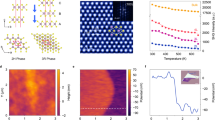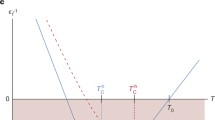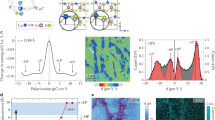Abstract
Ferroelectricity in atomically thin bilayer structures has been recently predicted1 and measured2,3,4 in two-dimensional materials with hexagonal non-centrosymmetric unit-cells. The crystal symmetry translates lateral shifts between parallel two-dimensional layers to sign changes in their out-of-plane electric polarization, a mechanism termed ‘slide-tronics’4. These observations have been restricted to switching between only two polarization states under low charge carrier densities5,6,7,8,9,10,11,12, limiting the practical application of the revealed phenomena13. To overcome these issues, one should explore the nature of polarization in multi-layered van der Waals stacks, how it is governed by intra- and interlayer charge redistribution and to what extent it survives the addition of mobile charge carriers14. To explore these questions, we conduct surface potential measurements of parallel WSe2 and MoS2 multi-layers with aligned and anti-aligned configurations of the polar interfaces. We find evenly spaced, nearly decoupled potential steps, indicating highly confined interfacial electric fields that provide a means to design multi-state ‘ladder-ferroelectrics’. Furthermore, we find that the internal polarization remains notable on electrostatic doping of mobile charge carrier densities as high as 1013 cm−2, with substantial in-plane conductivity. Using density functional theory calculations, we trace the extra charge redistribution in real and momentum spaces and identify an eventual doping-induced depolarization mechanism.




Similar content being viewed by others
Data availability
Source data are provided with this paper.
References
Li, L. & Wu, M. Binary compound bilayer and multilayer with vertical polarizations: two-dimensional ferroelectrics, multiferroics, and nanogenerators. ACS Nano 11, 6382–6388 (2017).
Woods, C. R. et al. Charge-polarized interfacial superlattices in marginally twisted hexagonal boron nitride. Nat. Commun. 12, 347 (2021).
Yasuda, K., Wang, X., Watanabe, K., Taniguchi, T. & Jarillo-Herrero, P. Stacking-engineered ferroelectricity in bilayer boron nitride. Science 372, 1458–1462 (2021).
Vizner Stern, M. et al. Interfacial ferroelectricity by van der Waals sliding. Science 372, 142–1466 (2021).
Fei, Z. et al. Ferroelectric switching of a two-dimensional metal. Nature 560, 336–339 (2018).
Yuan, S. et al. Room-temperature ferroelectricity in MoTe2 down to the atomic monolayer limit. Nat. Commun. 10, 1775 (2019).
Sharma, P. et al. A room-temperature ferroelectric semimetal. Sci. Adv. 5, eaax5080 (2019).
de la Barrera, S. C. et al. Direct measurement of ferroelectric polarization in a tunable semimetal. Nat. Commun. 12, 5298 (2021).
Wang, X. et al. Interfacial ferroelectricity in rhombohedral-stacked bilayer transition metal dichalcogenides. Nat. Nanotechnol. 17, 367–371 (2022).
Wan, Y. et al. Room-temperature ferroelectricity in 1T′-ReS2 multilayers. Phys. Rev. Lett. 128, 067601 (2022).
Weston, A. et al. Interfacial ferroelectricity in marginally twisted 2D semiconductors. Nat. Nanotechnol. 17, 390–395 (2022).
Lipatov, A. et al. Direct observation of ferroelectricity in two-dimensional MoS2. NPJ 2D Mater. Appl. 6, 18 (2022).
Lines, M. & Glass, A. Principles and Applications of Ferroelectrics and Related Materials (Oxford Univ. Press, 2001).
Wu, M. & Li, J. Sliding ferroelectricity in 2D van der Waals materials: related physics and future opportunities. Proc. Natl Acad. Sci. USA 118, e2115703118 (2021).
Eerenstein, W., Mathur, N. D. & Scott, J. F. Multiferroic and magnetoelectric materials. Nature 442, 759–765 (2006).
Setter, N. et al. Ferroelectric thin films: review of materials, properties, and applications. J. Appl. Phys. 100, 051606 (2006).
Anderson, P. W. & Blount, E. I. Symmetry considerations on martensitic transformations: ‘ferroelectric’ metals? Phys. Rev. Lett. 14, 217–219 (1965).
Xue, F., He, J. H. & Zhang, X. Emerging van der Waals ferroelectrics: unique properties and novel devices. Appl. Phys. Rev. 8, 021316 (2021).
Iwazaki, Y., Suzuki, T., Mizuno, Y. & Tsuneyuki, S. Doping-induced phase transitions in ferroelectric BaTiO3 from first-principles calculations. Phys. Rev. B. Condens. Matter Mater. Phys. 86, 214103 (2012).
Wang, Y., Liu, X., Burton, J. D., Jaswal, S. S. & Tsymbal, E. Y. Ferroelectric instability under screened Coulomb interactions. Phys. Rev. Lett. (2012).
Zhao, H. J. et al. Meta-screening and permanence of polar distortion in metallized ferroelectrics. Phys. Rev. B. 97, 054107 (2018).
Shi, Y. et al. A ferroelectric-like structural transition in a metal. Nat. Mater. 12, 1024–1027 (2013).
Zhou, W. X. & Ariando, A. Review on ferroelectric/polar metals. Jpn. J. Appl. Phys. 59, SI0802 (2020).
Dawber, M., Rabe, K. M. & Scott, J. F. Physics of thin-film ferroelectric oxides. Rev. Mod. Phys. 77, 1083–1130 (2005).
Jia, C. L. et al. Unit-cell scale mapping of ferroelectricity and tetragonality in epitaxial ultrathin ferroelectric films. Nat. Mater. 6, 64–69 (2007).
Böscke, T. S., Müller, J., Bräuhaus, D., Schröder, U. & Böttger, U. Ferroelectricity in hafnium oxide thin films. Appl. Phys. Lett. 99, 102903 (2011).
Liu, F. et al. Room-temperature ferroelectricity in CuInP2S6 ultrathin flakes. Nat. Commun. 7, 12357 (2016).
Alden, J. S. et al. Strain solitons and topological defects in bilayer graphene. Proc. Natl Acad. Sci. USA 110, 11256–11260 (2013).
Weston, A. et al. Atomic reconstruction in twisted bilayers of transition metal dichalcogenides. Nat. Nanotechnol. 15, 592–597 (2020).
Rosenberger, M. R. et al. Twist angle-dependent atomic reconstruction and moiré patterns in transition metal dichalcogenide heterostructures. ACS Nano 14, 4550–4558 (2020).
Ferreira, F., Enaldiev, V. V., Fal’ko, V. I. & Magorrian, S. J. Weak ferroelectric charge transfer in layer-asymmetric bilayers of 2D semiconductors. Sci. Rep. 11, 13422 (2021).
Magorrian, S. J. et al. Multifaceted moiré superlattice physics in twisted bilayers. Phys. Rev. B. 104, 125440 (2021).
Sinai, O. & Kronik, L. Simulated doping of Si from first principles using pseudoatoms. Phys. Rev. B - Condens. Matter Mater. Phys. 87, 235305 (2013).
Collins, L., Kilpatrick, J. I., Kalinin, S. V. & Rodriguez, B. J. Towards nanoscale electrical measurements in liquid by advanced KPFM techniques: a review. Reports Prog. Phys. 81, 086101 (2018).
Sung, J. et al. Broken mirror symmetry in excitonic response of reconstructed domains in twisted MoSe2/MoSe2 bilayers. Nat. Nanotechnol. 15, 750–754 (2020).
Chen, W. et al. Direct observation of van der Waals stacking–dependent interlayer magnetism. Science 366, 983–987 (2019).
Vaňo, V. et al. Artificial heavy fermions in a van der Waals heterostructure. Nature 599, 582–586 (2021).
Liu, X., Pyatakov, A. P. & Ren, W. Magnetoelectric coupling in multiferroic bilayer VS2. Phys. Rev. Lett. 125, 247601 (2020).
Perdew, J. P., Burke, K. & Ernzerhof, M. Generalized gradient approximation made simple. Phys. Rev. Lett. 77, 3865–3868 (1996).
Grimme, S., Antony, J., Ehrlich, S. & Krieg, H. A consistent and accurate ab initio parametrization of density functional dispersion correction (DFT-D) for the 94 elements H-Pu. J. Chem. Phys. 132, 154104 (2010).
Kresse, G. & Furthmüller, J. Efficient iterative schemes for ab initio total-energy calculations using a plane-wave basis set. Phys. Rev. B - Condens. Matter Mater. Phys. 54, 11169–11186 (1996).
Giannozzi, P. et al. QUANTUM ESPRESSO: a modular and open-source software project for quantumsimulations of materials. J. Phys. Condens. Matter 21, 395502 (2009).
Acknowledgements
We thank A. Cerreta (Park Systems) for atomic fluorescence microscopy support and N. Ravid for laboratory support. K.W. and T.T. acknowledge support from JSPS KAKENHI (grant nos. 19H05790, 20H00354 and 21H05233). M.G. has been supported by the Israel Science Foundation and the Directorate for Defense Research and Development grant no. 3427/21 and by the US-Israel Binational Science Foundation grant no. 2020072. L.K. thanks the Aryeh and Mintzi Katzman Professorial Chair and the Helen and Martin Kimmel Award for Innovative Investigation. M.U. acknowledges the financial support of the Israel Science Foundation, grant no. 1141/18, and the binational programme of the National Science Foundation of China and Israel Science Foundation, grant no. 3191/19. O.H. is grateful for the generous financial support of the Israel Science Foundation under grant no. 1586/17, The Ministry of Science and Technology of Israel (project no. 3–16244), the Heineman Chair in Physical Chemistry, and the Naomi Foundation for generous financial support from the the 2017 Kadar Award. M.B.S. acknowledges funding by the European Research Council under the European Union’s Horizon 2020 research and innovation programme (grant agreement no. 852925), and the Israel Science Foundation under grant nos. 1652/18 and 3623/21. O.H. and M.B.S. acknowledge the Centre for Nanoscience and Nanotechnology of Tel Aviv University.
Author information
Authors and Affiliations
Contributions
S.D. and N.R. conducted the experiments supervised by M.B.S. W.C. conducted the DFT calculations supervised by L.K., M.U. and O.H. K.W. and T.T. provided the h-BN crystals. S.D., W.C., N.R., M.G., L.K., M.U., O.H. and M.B.S. analysed the data, discussed the results and wrote the manuscript.
Corresponding author
Ethics declarations
Competing interests
The authors declare no competing interests.
Peer review
Peer review information
Nature thanks Erjun Kan and the other, anonymous, reviewer(s) for their contribution to the peer review of this work.
Additional information
Publisher’s note Springer Nature remains neutral with regard to jurisdictional claims in published maps and institutional affiliations.
Supplementary information
Supplementary Information
This file contains Supplementary Figs. 1–10, Table 1 and References.
Rights and permissions
Springer Nature or its licensor (e.g. a society or other partner) holds exclusive rights to this article under a publishing agreement with the author(s) or other rightsholder(s); author self-archiving of the accepted manuscript version of this article is solely governed by the terms of such publishing agreement and applicable law.
About this article
Cite this article
Deb, S., Cao, W., Raab, N. et al. Cumulative polarization in conductive interfacial ferroelectrics. Nature 612, 465–469 (2022). https://doi.org/10.1038/s41586-022-05341-5
Received:
Accepted:
Published:
Issue Date:
DOI: https://doi.org/10.1038/s41586-022-05341-5
- Springer Nature Limited
This article is cited by
-
Non-volatile electrical polarization switching via domain wall release in 3R-MoS2 bilayer
Nature Communications (2024)
-
Multiresistance states in ferro- and antiferroelectric trilayer boron nitride
Nature Communications (2024)
-
Electrostatic moiré potential from twisted hexagonal boron nitride layers
Nature Materials (2024)
-
Robust multiferroic in interfacial modulation synthesized wafer-scale one-unit-cell of chromium sulfide
Nature Communications (2024)
-
Engineering interfacial polarization switching in van der Waals multilayers
Nature Nanotechnology (2024)





